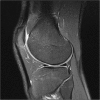Non-operative management of a complete anterior cruciate ligament injury in an English Premier League football player with return to play in less than 8 weeks: applying common sense in the absence of evidence
- PMID: 25917066
- PMCID: PMC4422908
- DOI: 10.1136/bcr-2014-208012
Non-operative management of a complete anterior cruciate ligament injury in an English Premier League football player with return to play in less than 8 weeks: applying common sense in the absence of evidence
Abstract
This case report illustrates and discusses the non-operative management of a complete anterior cruciate ligament (ACL) injury in an English Premier League football player, his return to play within 8 weeks and problem-free follow-up at 18 months post injury. When non-operative verses surgical ACL reconstruction is considered there are many fundamental gaps in our knowledge and currently, at elite level, there are no cases in cutting sports within the literature to guide these decisions. When the norm is for all professional footballers to be recommended surgery, it will be very challenging when circumstances and patient autonomy dictate a conservative approach, where prognosis, end points and risk are unclear and assumed to be high. This case challenges current dogma and provides a starting point for much needed debate about best practice, treatment options, research direction and not just at the elite level of sport.
2015 BMJ Publishing Group Ltd.
Figures






References
-
- Samuelsson K. Anatomic ACL reconstruction—current evidence and future directions [PhD thesis]. Sweden: Goteberg University, 2012. https://gupea.ub.gu.se/bitstream/2077/28254/1/gupea_2077_28254_1.pdf
-
- Smith TO, Postle K, Penny F et al. . Is reconstruction the best management strategy for anterior cruciate ligament rupture? A systematic review and meta-analysis comparing anterior cruciate ligament reconstruction versus non-operative treatment. Knee 2014;21:462–70. 10.1016/j.knee.2013.10.009 - DOI - PubMed
Publication types
MeSH terms
LinkOut - more resources
Full Text Sources
Other Literature Sources
